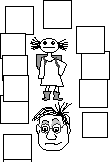|
Teachers role
|
The Teachers Role
[ Blooms Taxonomy ]
[ Teacher in Centre ]
It is commonly agreed upon that a new role of the teacher is
a key issue in connection with use of new technology. This is
obviously true, but there are few in-depth analyses of what this
role is, beyond some general statements that the role must put
more emphasize on counselling and less on traditional classrom
activities.
We may look for some footholds for a more nuanced description.
Blooms Taxonomy
Blooms taxonomy of educational objectives [15] in the cognitive
domain from the 50's are well known to pedagogues. It may serve
as a foothold for some central problems that challenge the teachers
role.
|
Evaluation |
appraises, concludes, confronts, criticizes,
decides, defends, interprets, judges, justifies, reframes, translates |
|
Synthesis |
adapts, anticipates, categories, collaborates,
combines, communicates, compares, compiles, composes, contracts,
contrasts, creates, designs, devises, expresses, facilitates,
formulates, generates, incorporates, individualises, initiates,
integrates, intervenes, models, modifies, negotiates, plans,
progresses, rearranges, reconstructs, reinforces, reorganises,
revises, structures, substitutes, validates. |
|
Analysis |
breaks down, correlates, diagrams, differentiates,
discriminates, distinguishes, focuses, illustrates, infers, limits,
outlines, points out, prioritises, recognises, separates, subdivides |
|
Application |
acts, administers, articulates, assesses, charts,
collects, computes, constructs, contributes, controls, determines,
develops, discovers, establishes, extends, implements, includes,
informs, instructs, operationalizes, participates, predicts,
prepares, preserves, produces, projects, provides, records, relates,
reports, shows, solves, takes, teaches, transfers, uses, utilises. |
|
Comprehension |
classifies, cites, converts, describes, discusses,
estimates, explains, generalises, gives examples, paraphrases,
summarises, understands. |
|
Knowledge |
defines, enumerates, identifies, labels, lists,
matches, names, reads, reproduces, restates, selects, states,
views |
A rich, unlimited access to information will easily support
an activity in the lower part of this ladder, both for students
and teachers. At the same time the situation demands that we gives
the learner training in operating on the top of the table. It
is important that the learner is trained in evaluation of available
information, and knowledge. To be conscious of own learning is
crucial in a perspective of life long learning.
One of the fundamental problems we experience in higher education
is that the students expect to be teached. This indicates and
invites a communication on the lower levels.
There is a great challenge to teachers in all levels of education
in this situation. The teachers role will in many ways be more
difficult when the access to information increases and the control
of the information decreases. A development in the direction of
mentor or counsellor is not trivial. The probably greatest, or
at least the most underestimated, demand is the demand for competence.
Teachers who settle for a communication on the lower levels will
inevitably be unmasked when confronted with alternative knowledge.
Such alternative knowledge must be explicitly evaluated, both
to evaluate its value in the actual situation, but most of all
to contribute to the students own training in evaluation.

Teacher in Centre
In the coarse models I have used to describe the three phases,
Skinner, Piaget and Rousseau, I have without further comments
placed the pupil or student alone in relation to a structure,
and have said nothing about the position of the teacher in relation
to these structures.

|
In Skinner's world it is clear that the teacher has prepared
the whole learning process in detail, and during the learning
takes on the role as observer and evaluator. The teacher is clearly
outside the structure and there is no active participation from
the teachers side once the setup is ready.
|

|
In the Piaget phase the program designer, teacher or not,
has laid down the rules and the premises for the learning that
takes place. There is a certain room for experimenting in a relatively
open structure, but this freedom is limited and within frames,
the microworld is closed. The existing freedom does lead to some
of the difficulties discussed earlier. The distance from the
teacher to the designer does also create a distance from the
teacher to both the product and the learning process.
|

|
I Rousseau's image the teacher has voluntary or involuntary,
given up control. Much of the praxis we see are implicit or explicit
attempts to regain control over the structure. Such attempts
are probably necessary and in some cases wise, but there is a
great danger that it is done on wrong premises. It happens to
a great extent after a model which are outdated by the technology.
The teacher as a director and controller of information is no
longer possible.
|

|
The challenge is to take part in the learning on the premises
of the student and the surroundings. If we extend the metaphor
we have used to illustrate the history, we must find a place
for the teacher within the structure. Teacher and student must
to a great extent share the challenges and cooperate in transforming
information into knowledge, whether it is done in a project oriented
approach or not.
|
There is of course nothing new in this approach. The interesting
and challenging part is that it is the technology which provokes
this situation, and suggests a solution. Papert, who introduced
Logo in the 80's, have made some interesting comments on this
situation[17]. He claims that the technology for the first time
has made activity pedagogy feasible. It is tempting to say that
it is not only possible, but necessary.

|